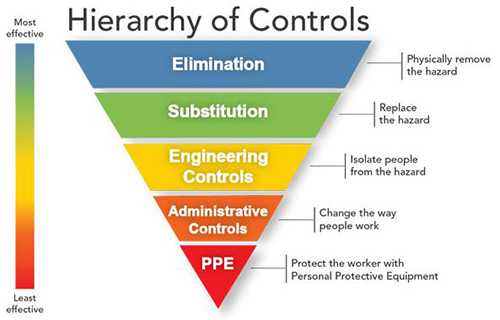Work-related Asthma
How are work-related asthma exposures identified and prevented?
The following guidelines can help employers and employees develop and maintain a worksite safe from asthma triggers. Minimizing exposure to work-related asthma triggers can help employees to be healthier.

Employers
The hierarchy of controls (image below) is an approach that groups actions by their likely effectiveness in removing or reducing hazards. The preferred approach includes the following:
- Eliminate or substitute hazardous processes or materials. When developing a project, take necessary precautions to prevent potentially harmful exposures and reduce the need for additional controls in the future.
- Install engineering controls to reduce exposure or shield employees. For example, isolate or enclose processes, and install local exhaust ventilation to capture exposures at the source.
- Implement administrative controls such as work practices or policies that reduce or prevent hazardous exposures.
- Train workers on potential workplace hazards, what precautions they should take to protect themselves, and workplace policies for reporting their concerns.
- Establish a no-smoking policy in the workplace. Tobacco smoke is a trigger for some people with asthma.
Some employers might want to consider establishing a medical surveillance plan to monitor for asthma through questionnaires and routine lung function testing (spirometry). A surveillance plan might identify workers with asthma at earlier stages of disease, when workers are more responsive to treatment.
Personal protective equipment (PPE) might also be needed. PPE is the least effective means of controlling hazardous exposures and should not be the sole method for controlling hazardous exposures. Rather, PPE should be used until effective engineering and administrative controls are in place. Proper use of PPE requires a comprehensive program and a high level of employee involvement and commitment. Additionally, the right personal protective equipment must be chosen for each hazard.

Employees
Employees should be attentive to their work environment, especially those with breathing problems. Follow the steps below if
you feel you have work-related asthma symptoms.
- Identify and avoid exposures to asthma triggers.
- Participate in your employer’s asthma surveillance plan, if available.
- Report new or worsening breathing problems to your doctor and the designated person at your workplace.
- Immediately report if personal protective equipment or engineering controls malfunction to your supervisor.
- If you have asthma, take your medications as prescribed and regularly see your doctor.
- Get a flu shot every year.
- If you smoke, talk to your doctor or employer about resources to help you quit smoking.
- Page last reviewed: May 22, 2017
- Page last updated: July 11, 2017
- Content source:
National Institute for Occupational Safety and Health Respiratory Health Division


 ShareCompartir
ShareCompartir